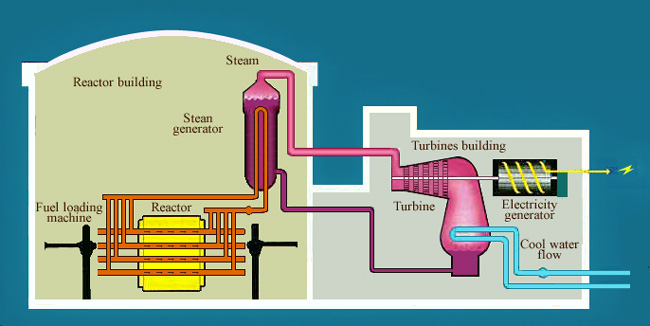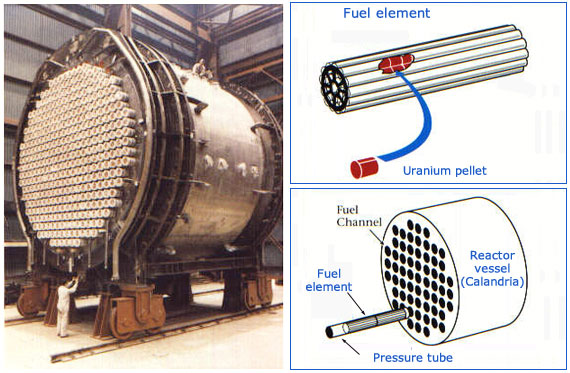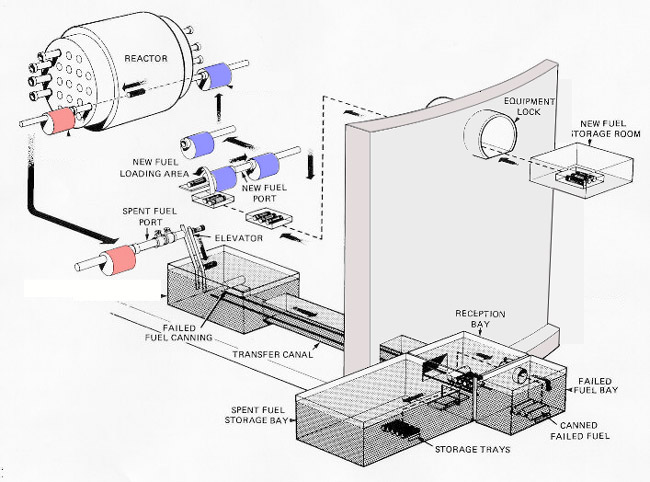Canadian reactors using natural uranium and heavy water

Chalk River Laboratories
It was on the Chalk River site, along the Otawa River, that was built from 1945 the great heavy water atomic pile that was at the origin of the development by Canada of the CANDU reactors, whose name means CANada Deuterium Uranium.
© IAECL
CANDU is a nuclear reactor brand developed since the 1950s in Canada. Its origin dates back to an agreement signed April 19, 1943 in Quebec establishing a nuclear cooperation between the United States and United Kingdom during the second world war. While the Manhattan project was in full swing, Americans refused to share with their best ally their secret research on uranium enrichment and plutonium extraction. However, in the spring of 1944, they accept the construction of a large atomic pile based on heavy water, in a joint collaboration between Britain, the United States and Canada. The atomic pile was built in two years starting from 1945, in a beautiful and isolated site at Chalk River, along the Otawa River.

Layout of a CANDU reactor
One finds on this diagram the classical elements of a reactor, with the production of electricity from steam. But the hot water pressurized leaving the reactor core to the steam generator is heavy water. The uranium entering into the fuel is natural uranium. This makes Candu reactors attractive for countries that do not access to enriched uranium facilities. One essential and original feature of CANDUs is a loading-unloading machine that allow to load or unload fuel elements without having to shut down the reactor.
© IAECL
CANDU reactors are heavy water reactors burning natural uranium as nuclear fuel . The use of natural uranium made this option attractive at a time when many countries did not have access to enriched uranium. The difficulty was to have heavy water. All Canadian reactors belong to the CANDU system that was exported particularly in India and Pakistan.
The discovery and separation of deuterium was due in 1932 to the American chemist Harold Urey, who succeeded, after long distillation and water fractional electrolysis processes, in isolating heavy water as a tiny fraction of ordinary water. In 1940, the world stock of heavy water held by the Norwegian Company of Nitrogen amounted to 185 kg … It was these 185 kg that a French mission brought back to the Collège de France on March 9, shortly before the German offensive of May 1940 (A film « The battle of heavy water battle » was devoted to them). Then, the precious 185 kg made their way to England. Later on, the production of heavy water with the development of the industry began in Canada from 1943. Today, if the world stock is no more counted in kilos, heavy water remains a rare and expensive material to produce.
CANDU reactors use heavy water both as a moderator and a coolant. They can be pressurized. Pressurized heavy water, as in a PWR reactor, can reach higher temperatures without boiling and can release more heat from the reactor core. In 2011, 46 Candu reactors with pressurized heavy water were in operation worldwide, including 11 in India.

Calandria and fuel elements
The structure containing the pressure tubes and the moderator is called the calandria. Fuel tubes and the reactor core are horizontals. Loading machines see both faces of the calandria, one for loading and one for unloading, allowing operators to introduce fresh fuel and remove spent fuel at each channels end : 6 to 10 elements loaded and unloaded every day. The heavy water slowdown of neutrons leads to a core less compact than light water reactors cores. This facilitates the access to fuel channels for loading and unloading.
© AECL
Heavy water molecules have their two hydrogen replaced by heavy hydrogen atoms, named deuterium, whose nucleus is made of a proton and a neutron instead of a single proton. Heavy water is, with ultra-pure graphite, the only moderator that allows to use natural uranium.
A reactor using natural uranium, poor in fissile uranium-235, can operate only with low-energy neutrons, called thermals. The challenge is to obtain these thermal neutrons with minimum losses during the collisions that slow down neutrons. A deuterium nucleus captures neutrons 600 times less often than the hydrogen protons of ordinary water, hence the use of heavy water as a moderator.

A continuous fuel loading
The continuous loading of the nuclear fuel, a feature of CANDU reactors, is done channel by channel. Two identical devices, remotely controlled from the control room, load a new fuel tube while unloading a spent fuel tube. Once the two devices are locked at both ends of the selected channel, they are pressurized. The two ends are opened and a spent fuel assembly is replaced with a new one. One loading device is doing the loading and the other the unloading.
© AECL
The natural uranium fuel is continuously loaded at full power, a faculty permitted by the subdivision of the reactor core between several hundred tubes. These tubes are composed of several elements of about 20 kg, 50 cm long made of natural uranium immersed in cooling pressurized heavy water. Each of these tubes is also surrounded by an outer tube filled also with heavy water, but at low pressure and temperature, which acts as a moderator.
The continuous loading and unloading of the uranium fuel is one of the characteristics of CANDU reactors. Since natural uranium contains only 0,7% of the fissile 235 isotope, the reactor core is designed to be constantly reloaded with fresh fuel replacing spent fuel. This is unlike light water reactors, such as PWRs, where the enriched fuel is replaced by third every year. In theory, a CANDU reactor does not need to be shut down.
Born from the idea of turning uranium into weapon—grade plutonium-239, CANDU reactors may favor nuclear prolifération. The faculty to unload at any time fuel element allows early fuel unload. One can then extract weapon-grade plutonium-239 from these little irradiated fuel elements. For instance, India and Pakistan who had not signed the Non-Proliferation Act and were not subject to IAIA inspections, had CANDU reactors. Both countries may have used this feature to start their nuclear arsenal.
Under normal operating conditions, fuel elements stay long enough in reactor for plutonium to lose its weapon-grade quality.
Other articles on the subject « Nuclear Reactors »
Reactor Families
A variety of designs : Natural uranium or enriched uranium as fuel There are several industrial t[...]
World nuclear reactors
A development that takes place today in Asia At the beginning of 2014 the number of reactors in o[...]
Generation I reactors
1950-1970: First generation of reactors (50 – 500 MWe) The first generation reactors were i[...]
RBMK reactors
Soviet-era reactors at Chernobyl Cold War and the Iron Curtain led after 1947 to the development [...]
Generation II Reactors
1970-2009: the rise of nuclear energy About 85% of electricity produced worldwide by nuclear powe[...]
PWR Reactors
The most widespread type of reactor … Pressurised water reactors (PWR) are by far the most [...]
PWR Operation
High pressure water to evacuate heat and slow down neutrons The reactor core is the source of ene[...]
Boiling Water Reactors
BWR or Boiling Water Reactors Boiling water reactors or BWR are in operation in the United States[...]
Nuclear Propulsion
On-board reactors for submarines and aircraft carriers In addition to conventional land-based pow[...]